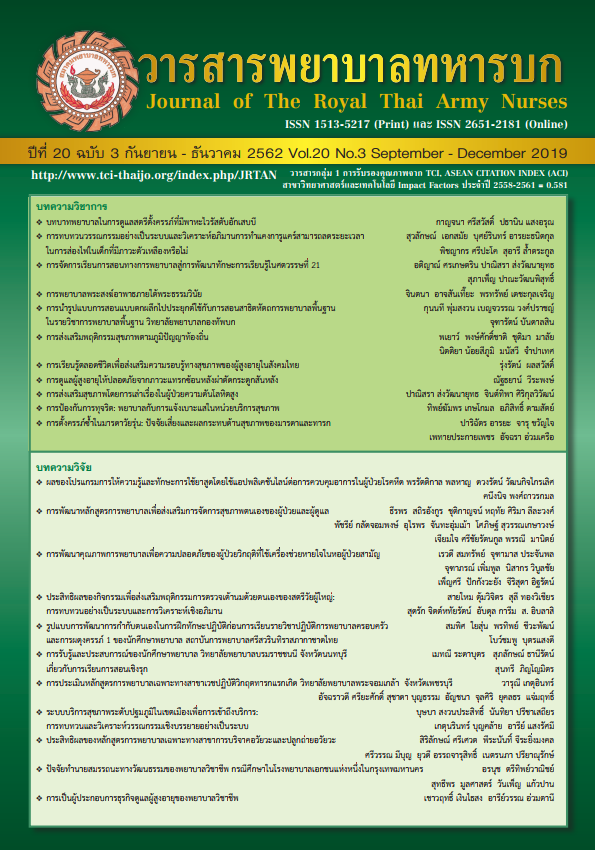The Effect of Teaching Using Computer Assisted Instruction on Gerontological Nursing Lesson of Nurse Students at Faculty of Nursing Chaiyaphum Rajabhat University
Keywords:
Computer Assisted Instruction, Gerontological nursing, Nurse StudentsAbstract
The purpose of this quasi-experimental research were to construct and evaluate effectiveness of The computer-assisted instruction (CAI) on gerontological nursing lesson of Depression, Dementia, Parkinson, Geriatric assessment. The 30 nurse students of faculty of nursing at Chaiyaphum Rajabhat University in third year and studying gerontological nursing course were purposive sample to one group. The instrument consisted of 1) the CAI on gerontological nursing of Depression, Dementia, Parkinson and Geriatric assessment by Tutorial Instruction Pattern and 2) Satisfaction Questionnaire, Questionnaire about the CAI on gerontological nursing of Depression, Dementia, Parkinson and Geriatric assessment by Tutorial Instruction Pattern and 3) Test of gerontological nursing. The Efficiency of CAI by E1/E2, E.I. and mean, standard deviation, compare mean score of learning achievement in gerontological nursing were used to analyze data. The results revealed that the constructed CAI efficiency was 87/84 with E.I. value as 0.7 , higher than the expected criteria. The mean score of students’ knowledge at post-test (x = 9.00) were higher than those at pre-test (x = 6.00), with a significant level of p < 0.001. Moreover, The score of satisfaction toward the CAI were high on every item. It is suggested that students were able to acquire knowledge in nursing care of gerontological nursing by the computer assisted instruction.
Downloads
References
2. Brahmawong C. Developmental testing of media and instructional package. Silpakorn Educational Research Journal 2013; 5(1): 1-20. (in Thai)
3. Chaimanee T, Dissataporn C, Rojsomrith W & Onming R. The efficiency of computer based simulation via internet on practice guidelines prevention of nosocomial infection for nursing students. Academic services journal Prince of songkla university 2017; 28(1): 130-42. (in Thai)
4. Howerton WB, Enrique PR, Ludlow JB & Tyndall DA. Interactive computer-assisted instruction vs lecture Format in dental education. J Dent Hyg 2004; 78(4): 1-6.
5. Institute of population and social research. Population of Thailand 2018. Mahidol population gazette 2018; 1(3): 50-62. (in Thai)
6. Jehdoloh S, Kaveevivitchai C, Piaseu N & Neelapaichit N. A Computer-assisted selfcare programme for Thai Muslims with hypertension. Thai journal of nursing council 2016; 31(1): 83-94. (in Thai)
7. Malithong K. Educational technology and communications. Bangkok: Aroonprinting. 2005. (in Thai)
8. Mamom J. Computer assisted instruction (CAI): educational technology to develop the knowledge and skills of nursing students. Journal of science and technology 2014;22(2): 286-93. (in Thai)
9. Norasan S & Khuwatsamrit K. The effect of computer-assisted instruction (CAI) on nursing’s student learning achievement toward nursing management for patient with intercostals chest drainage(ICD). Journal of nursing education 2008; 1(3): 0-62. (in Thai)
10. Pakdeto R, Sawasdipanich N & Suntiti R. Effect of a computer-assisted instruction of nursing care of children with intravenous fluid therapy toward knowledge and clinical decision-making of nursing students. Journal of Boromarajonani College of Nursing 2013;29(1): 110-20. (in Thai)
11. Panich V. The development 21st century learning. Bangkok: The Siam Commercial Bank. 2013.
12. Perciful EG. Curriculum planning and computerassisted instruction(CAI) within clinical nursing education. In: Saba VK, Pocklington DB & Miller KP. Nursing and computers: an anthology 1987-1996. USA; springer, 1993.
13. Phimarn W, Anakeveang A, Sato VH & Cushnie B. The evaluation and development of computerassisted instruction program in pharmacology
of asthma. Thai pharmaceutical and health science journal 2012; 7(1): 16-21. (in Thai)
14. Phothidara Y. Nursing Education Management : For Student Generation Y. Journal of Nursing Science & Health 2011; 34(2): 61-69. (in Thai)
15. Pienpitak S. The development of computer assisted instruction and website for quality of learning. Bangkok; Ministry of education. 2003.
16. Prasarnsoy W. Computer-assisted instruction: innovation for educations. 2nd edition. Bangkok: VJ printing. 2004. (in Thai)
17. Rojanaprasert P & Booniamsak T. The effect of computer-assisted instruction lessons with reflective thinking teaching in nursing care of the child with cardiac catheterization on knowledge and critical thinking among the nursing students. Thai journal of cardiothoracic nursing 2013; 1(3): 50-62. (in Thai)
18. Rouse DP. Computer-assisted instruction: an effective instructional method. Teaching and learning in nursing; 2: 138-43. 2007.
19. Sikkhabandit S. Policy of Thailand 4.0: opportunity threat and beneficience of Thailand in asean community. Bangkok: national reform steering
Assembly. 2017. (in Thai)
20. Somnarin O & Boonkusol T. The effect of computer-assisted instruction with thoracic examination on learning outcome and satisfaction in nursing students. Journal of boromarajonani college of nursing 2016;32(2): 94-104. (in Thai)
Downloads
Published
How to Cite
Issue
Section
License
บทความหรือข้อคิดเห็นใดใดที่ปรากฏในวารสารพยาบาลทหารบกเป็นวรรณกรรมของผู้เขียน ซึ่งบรรณาธิการหรือสมาคมพยาบาลทหารบก ไม่จำเป็นต้องเห็นด้วย
บทความที่ได้รับการตีพิมพ์เป็นลิขสิทธิ์ของวารสารพยาบาลทหารบก
The ideas and opinions expressed in the Journal of The Royal Thai Army Nurses are those of the authors and not necessarily those
of the editor or Royal Thai Army Nurses Association.






